The name Brontophonic comes from the Greek word "brontos" which means "thunder", and "phonos" meaning "sound." In other words, brontophonic means something like "the sound of thunder".
This design is based on this fact, using a new concept of sound where the sensation of hearing is produced within our brain. Although some researchers are trying to use this concept in hi-fi applications, including the author who has published a few articles on this many years ago, bronchophonic sound can be used for other purposes, including paranormal experiments as described here.
To give the reader an idea of ??what bronchophonic sound is, we begin by explaining a more familiar physical phenomenon that is the "beat."
Beat
In your high school or physics lab, you may have learned what the tuning fork is, like in Figure 1.
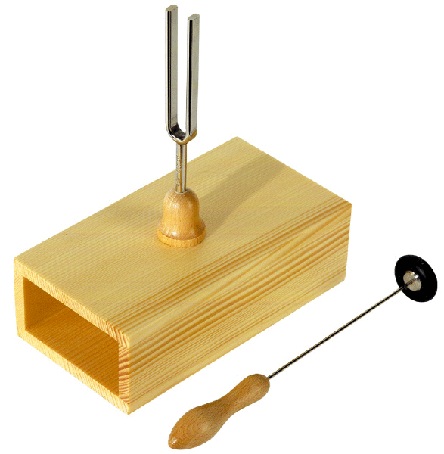
When a tuning fork is driven, it vibrates at its natural frequency that is determined by its size, material and shape. The sound produced in this way is called "pure", as it corresponds to a sine wave.
An important phenomenon occurs when two different tuning forks (at different frequencies) are placed to vibrate in the same location at the same time.
If you pay attention, you will not only hear the basic sounds (for which they were cut), you may also hear a much lower and a higher pitch. This phenomenon occurs when the two produced sounds are mixed inside your ear, specific on the tympanic membrane (Figure 2).
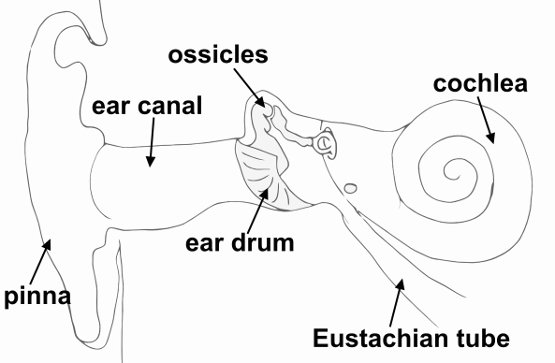
One of the additional frequencies heard is the sum of the frequencies of the tuning forks and the other is the frequency difference. If one of the tuning forks vibrates at 800 Hz and the other at 300 Hz, you would hear a lower frequency sound of 500 Hz (800-300 Hz) and a higher frequency sound, 1 100 Hz (800 + 300 Hz).
This phenomenon caused by the interference of sound waves is called a beat. Many electronics such as radios, TV, telecom devices have circuits which use the beat principle in their operation to lower the frequency of a signal to a value that can be used in the processing circuits.
If you look at how the two additional frequencies are produced (500 and 1,100 Hz), you will find that the phenomenon occurs because each eardrum spot simultaneously receives vibrations from two different sources and has to vibrate in two frequencies at one time. The result is a combined movement of each point of the eardrum which produces the two additional frequencies.
The important point to note in this phenomenon is that the two new frequencies are not produced by sound sources, but are created within the ear, or on a speaker, at any point observed in space.
Let us now go a step further and transpose the same concepts to ultrasound sources, one operating at 19,000 Hz and the other at 20,000 Hz. (Remember that we cannot hear sounds at frequencies above 18,000 Hz.)
The vibrations produced by any source separately cannot be heard by anyone. But when the two tones are mixed inside the ear, they produce two new tones.
One of them, the 39,000 Hz sum tone is above the upper auditory limit, but the other, the 1,000 Hz difference tone is in the audible frequency range and can be heard.
The interesting part of this phenomenon is: because the tone of difference is
produced inside the ear (or, more precisely, at the eardrum), you will have the
strange feeling that the sound comes from inside your head or that the sound
comes from nowhere.
If ultrasonic sounds are produced by high power sources, the sound of the beat generated within you will cause some discomfort and exposure to vibrations of this type can even cause panic or have other physiological effects. (In some cases, it has been reported that low-frequency beats can cause dysentery!)
How it works
This design is made up of a pair of powerful ultrasonic modulated oscillators operating in ranges between 18,000 and 25,000 Hz. A 4093 IC is used as the basis of the design.
Each of the four NAND gateways of the 4093 is connected to an oscillator. In the first block we have the lCl-a operating in a very low frequency range (modulation circuit) given by R1 and C1. This circuit modulates (in frequency) the second oscillator, elaborated with the NAND gate lC! -B.
This oscillator operates in a frequency range between 18,000 and 25,000 Hz given by C3 and adjusted by P1. The frequency modulated signal produced by this circuit is applied to a high power output stage using a power FET.
How can a piezoelectric tweeter be used. Many common tweeters
can reproduce sounds above our audible limit with good performance and
can be used as an ultrasonic transducer. Common piezoelectric tweeters can produce several watts of ultrasound in the range of up to 25,000 Hz.
Be careful about the tweeter characteristics you use. Choose one that can go up to 25,000 Hz or more.
The other low frequency oscillator has its frequency determined by C5 and R7, serving to modulate the fourth oscillator, made around ICl-d. This oscillator operates in the ultrasonic range and has its frequency set by P2. The signal from the second ultrasonic oscillator also drives a power output stage with a power MOSFET and a second tweeter is used as a transducer.
The circuit can be powered from 6 to 12 V sources and can fill a multi watt environment of ultrasonic vibrations as described above. It is only necessary to place the tweeters a few feet away to fill an environment with different ultrasound signals producing the strange effects described in this section.
Some low-frequency beats which may occur with this device in the alpha, beta, and theta brainwave range can induce seizures. Do not use this device in experiments that would require people to remain in the ultrasonic field reach during extended sessions! Avoid using this device near anyone who has a history of epilepsy.
Very low frequency beats can also create physiological / psychological effects in humans and, in some cases, may even causing dysentery!
Assembly
Figure 3 shows the schematic diagram of the bronchophonic oscillator. The
printed circuit board for this design is shown in Fig. 4.
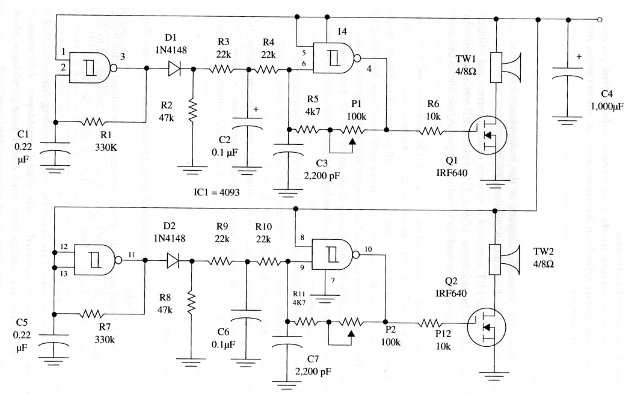
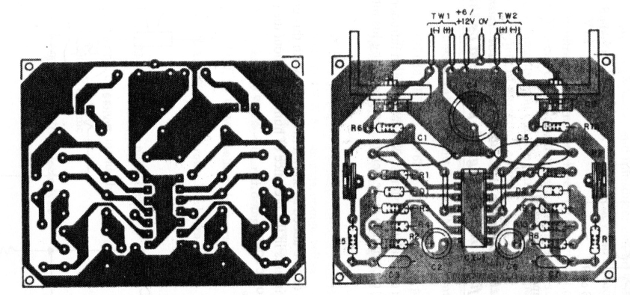
Any P-channel power MOSFET for 4 A or more drain current and voltages of 200 V or more can be used in this design. Common IRF series types in switched power supplies, such as those found in computers, are cheap and fit for this project.
Transistors must be mounted on heatsinks. The heat sinks are pieces of metal, 5 x 8 cm, folded to form a "U" and bolted to the transistors.
The small tweeters, as shown in the figures, with powers of 50 W or more, are suitable and can be connected to the circuit with wires from 2 to 40 in length. The tweeters should be placed as far apart as possible for best results.
A suitable power supply for this circuit is shown in Fig. 5.
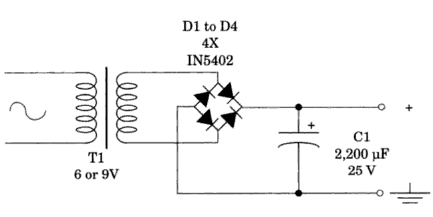
The transformer has a primary winding specified for the grid voltage and a secondary winding for 6 to 9 V and 2 A current.
The circuit can also be powered from four to six cells D. As the drain current is high, the continuous operation time when using cells is not long. A wooden box can be used to house the circuit.
Although in the original design we recommend trimpots, the reader is free to modify the design to use common potentiometers placed on the front panel. This will allow the searcher to have additional control over the generated signal.
Using the circuit
Place the two tweeters separated from each other at a distance of at least 2 m.
Set P1 and P2 until you get the strange sensation of modulated sound
produced within your brain. Do not expose yourself for a long time to this
sound as it can produce panic and other unpredictable dangerous effects.
Suggestions
A volume control can be added as shown in Fig. 6. With this control, you can perform the experiments in the presence of humans without the discomfort of a high-power ultrasonic source.
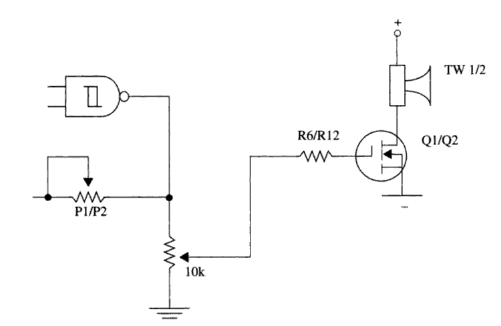
- Only one oscillator can be used in experiments involving pure ultrasound. You can add a switch in series with each tweeter to turn it on and off whenever you want.
- You can add a switch to disable either oscillators to run experiments with only one ultrasonic source.
- A special low impedance ultrasonic transducer can be tested with this circuit. Depending on the transducer used the frequency can be increased to more than 30,000 Hz.
- The ultrasonic signal of high power produced by this circuit can frighten the birds of a property. You can do other experiments in this area.
- In complex experiments, you can use more than one of these circuits to fill an environment with several ultrasonic sounds.
IC-1- 4093- 4 NAND Schmitt Gates. CMOS integrated circuit
Q1, Q2 - IRF640, IRF720, IRF620 or equivalent. Any MOSFET
(see text)
D1 D2 - 1N4l48, 1N9l4 or equivalent, general purpose silicon diodes
Resistors
R1, R7 - 330k x 1/8 W - orange, orange, yellow
R2, R8 - 47k, 1/8 W, 5% - yellow, violet, orange
R3, R4, R9, R10-22k, 1/8 W- red, red, orange
R5, R11 - 4.7 k, 1/8 W, 5% - yellow, violet, orange
R6, R12 - 10k, 1/8 W. 5% - brown, black, orange
Capacitor:
C1. C5 - 0.22 uF, ceramic or metal film
C2, C6 - 0.1 uF, ceramic or metal film
CS, C7-2200 pF, ceramic
C4 1,000 uF x 16 WVDC, electrolytic
Miscellaneous
Printed circuit board, power supply, wooden or plastic box, heatsinks, buttons for potentiometers, wires, welding, etc.



